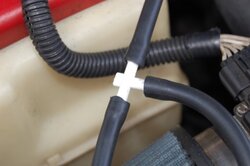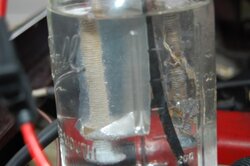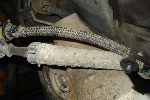aldive
Elite In Memoriam
- Joined
- January 17, 2001
- Messages
- 24,667
- Reaction score
- 28
- Year, Model & Trim Level
- 1999 XLT
To further my quest for exceptional gas mileage (http://www.explorerforum.com/forums/showthread.php?t=44372&highlight=quest ), after a good deal of research into hydrogen fuel use in automobiles, I decided to try HHO for myself.
The literature is full of positive results when using HHO to increase gas mileage up to 50% as well as the naysayers who readily debunk the concept and brand it alchemy. Hopefully this experimentation will shed some light to the viability of HHO use in a real world application.
So what is this HHO stuff and what will it do for me?
HHO is an oxyhydrogen mixture made by electric arc technology; it contains 2 parts of hydrogen per 1 part oxygen. It is also known as Brown’s Gas and Hydroxy.
Is this gas safe or will my vehicle go up in flames like the Hindenburg? Yes it is safe; the HHO gas is extracted as required and burned steadily from the water, unlike stored pressurized large volumes of pure hydrogen which is extremely combustible.
When water, distilled in this case, is exposed to electrical energy it become excited and divides into Hydrogen and Oxygen gases. The gases enter the vehicles motor via intake vacuum.
Before jumping on the HHO bandwagon, I highly recommend doing your homework. Read everything you can get your hands on. With new technology ( though HHO is far from new, its use in this application is ) knowledge is everything.
I plan on testing several of the plethora of ready made HHO kits and eventually building one of my own design. For this first trial, I ordered a ready made HHO generator kit from one of our members, Chris Swain ( SwaintaN ). After many e mail communications with him, I decided to obtain one of his single cell units.
Not knowing exactly what to expect with the “kit”, I was somewhat taken aback when I opened the box and saw a glass Ball canning jar with some wires and a hose protruding from the plastic top. The real surprise was that there were no instructions whatsoever included.
I immediately e mailed Chris. Within an hour he replayed: “no they werent suppose to be in it, that is one way I can see the kits cheaper then other people. I email the install instructions”. That’s the first I heard anything about that. Oh well, I have them now.
The negative wire was about a foot of yellow wire. It was attached to the negative terminal, a wing nut, on the top of the jar by simply stripping the wire and looping under the wing nut. This was absolutely unacceptable in my opinion.
The positive wire was attached in a similar manner. However, it had a fuse holder with a 15 amp fuse attached.
The first thing I did was install ring terminals on the wires that attach to the generator and completely rewire the negative lead and remove the extension wire that was simply taped wire to the positive lead.
Subsequently, I had to find a location to mount the generator. The engine bay area in my Explorer is already jam-packed, and given that the generator is made of glass, extra care had to be taken. The mounting location had to be accessible to refill the generator. I fit the HHO generator in behind the passenger side headlight.
The HHO generator was hooked up on my ’99 Explorer by “T”ing the output hose with one leg going to intake vacuum near the PCV filter ( http://www.explorerforum.com/forums/showthread.php?t=148135 ) and the other going into my Mac intake ( I installed a 1/4” fitting into rubber connector on the intake tube ).
After everything was hooked up, I charged the system with distilled water and 1 teaspoon of sodium bicarbonate (baking soda ). This is an area in which I plan to experiment to determine the optimal amount of baking soda.
The ignition was turned on and the bubbles were observed. The truck was started and driven through the neighborhood. All appeared normal; no differences were observed nor were they expected.
My ongoing concern is how to tune or modify so that the PCM doesn’t increase fuel as the O2 sensors read a lean condition due to the burn of HHO. Further research and testing will be required. I don’t expect optimal mileage until this issue is resolved.
The PCM tune used to study the HHO generator was one of my custom maximum gas mileage tunes using 89 octane fuel.
The relatively uncomplicated installation took only about 1 hour.
The cost of the generator used in this trial was $55.00 to my door. I decided to use the cheapest ready made kit I could find for the first phase of this research and upgrade from there.
In addition to the kit, I had to purchase an additional T fitting ( 3/8” - ¼” ) to tap into the intake vacuum line and a fitting ( ¼” ) for the Mac intake. I acquired these goods at my local Advance Auto Parts store.
I shall withhold endorsement of this kit until the mileage results are in, however, the quality of the kit is not up to my standards. The instructions do not explain a lot of things, yet when asked by e mail, were explained by Chris. He is very helpful and very prompt with e mail replies.
Will the HHO generator enhance my already very good gas mileage? Only time will tell. I plan a road tryout in the next few days. I also plan on evaluating this device in my son’s Nissan Titan as well as another friends stock Lexus SUV and then on our carbureted Jeep.
Stay tuned for the data …
The literature is full of positive results when using HHO to increase gas mileage up to 50% as well as the naysayers who readily debunk the concept and brand it alchemy. Hopefully this experimentation will shed some light to the viability of HHO use in a real world application.
So what is this HHO stuff and what will it do for me?
HHO is an oxyhydrogen mixture made by electric arc technology; it contains 2 parts of hydrogen per 1 part oxygen. It is also known as Brown’s Gas and Hydroxy.
Is this gas safe or will my vehicle go up in flames like the Hindenburg? Yes it is safe; the HHO gas is extracted as required and burned steadily from the water, unlike stored pressurized large volumes of pure hydrogen which is extremely combustible.
When water, distilled in this case, is exposed to electrical energy it become excited and divides into Hydrogen and Oxygen gases. The gases enter the vehicles motor via intake vacuum.
Before jumping on the HHO bandwagon, I highly recommend doing your homework. Read everything you can get your hands on. With new technology ( though HHO is far from new, its use in this application is ) knowledge is everything.
I plan on testing several of the plethora of ready made HHO kits and eventually building one of my own design. For this first trial, I ordered a ready made HHO generator kit from one of our members, Chris Swain ( SwaintaN ). After many e mail communications with him, I decided to obtain one of his single cell units.
Not knowing exactly what to expect with the “kit”, I was somewhat taken aback when I opened the box and saw a glass Ball canning jar with some wires and a hose protruding from the plastic top. The real surprise was that there were no instructions whatsoever included.
I immediately e mailed Chris. Within an hour he replayed: “no they werent suppose to be in it, that is one way I can see the kits cheaper then other people. I email the install instructions”. That’s the first I heard anything about that. Oh well, I have them now.
The negative wire was about a foot of yellow wire. It was attached to the negative terminal, a wing nut, on the top of the jar by simply stripping the wire and looping under the wing nut. This was absolutely unacceptable in my opinion.
The positive wire was attached in a similar manner. However, it had a fuse holder with a 15 amp fuse attached.
The first thing I did was install ring terminals on the wires that attach to the generator and completely rewire the negative lead and remove the extension wire that was simply taped wire to the positive lead.
Subsequently, I had to find a location to mount the generator. The engine bay area in my Explorer is already jam-packed, and given that the generator is made of glass, extra care had to be taken. The mounting location had to be accessible to refill the generator. I fit the HHO generator in behind the passenger side headlight.
The HHO generator was hooked up on my ’99 Explorer by “T”ing the output hose with one leg going to intake vacuum near the PCV filter ( http://www.explorerforum.com/forums/showthread.php?t=148135 ) and the other going into my Mac intake ( I installed a 1/4” fitting into rubber connector on the intake tube ).
After everything was hooked up, I charged the system with distilled water and 1 teaspoon of sodium bicarbonate (baking soda ). This is an area in which I plan to experiment to determine the optimal amount of baking soda.
The ignition was turned on and the bubbles were observed. The truck was started and driven through the neighborhood. All appeared normal; no differences were observed nor were they expected.
My ongoing concern is how to tune or modify so that the PCM doesn’t increase fuel as the O2 sensors read a lean condition due to the burn of HHO. Further research and testing will be required. I don’t expect optimal mileage until this issue is resolved.
The PCM tune used to study the HHO generator was one of my custom maximum gas mileage tunes using 89 octane fuel.
The relatively uncomplicated installation took only about 1 hour.
The cost of the generator used in this trial was $55.00 to my door. I decided to use the cheapest ready made kit I could find for the first phase of this research and upgrade from there.
In addition to the kit, I had to purchase an additional T fitting ( 3/8” - ¼” ) to tap into the intake vacuum line and a fitting ( ¼” ) for the Mac intake. I acquired these goods at my local Advance Auto Parts store.
I shall withhold endorsement of this kit until the mileage results are in, however, the quality of the kit is not up to my standards. The instructions do not explain a lot of things, yet when asked by e mail, were explained by Chris. He is very helpful and very prompt with e mail replies.
Will the HHO generator enhance my already very good gas mileage? Only time will tell. I plan a road tryout in the next few days. I also plan on evaluating this device in my son’s Nissan Titan as well as another friends stock Lexus SUV and then on our carbureted Jeep.
Stay tuned for the data …






















